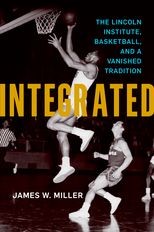Integrated: The Lincoln Institute, Basketball, and a Vanished Tradition
Integrated: The Lincoln Institute, Basketball, and a Vanished Tradition
Cite
Abstract
It is 1960, six years after the US Supreme Court ruled that segregation in the public schools was prohibited and states were ordered to come up with plans for integrating African Americans into the white school systems. An unanticipated response to desegregation was that not all African Americans favored the process, because it meant that some of their cherished institutions would be changed forever. Few such institutions were affected more than the strong tradition of black high school basketball. And nowhere in the nation was that tradition stronger than in basketball-mad Kentucky, where more than fifty black high schools proudly competed in their own league for more than a quarter century. The Kentucky experience of desegregation reflects the dissonance when logic meets emotion. The story centers on Lincoln Institute, a black high school near Louisville founded in 1912 after the state legislature passed a law “to prohibit white and colored persons from attending the same school.” Lincoln Institute was led by a charismatic academic and theologian named Whitney M. Young. In more than three decades as the school's leader, Young overcame prejudice, funding issues, and politics to create a bastion of excellence and respect in the black community. In Integrated, former Lincoln Institute players, students, and teachers tell their stories of angst, regret, and resilience during a largely ignored transitional period in the nation's story of desegregation. Their experiences within the broader racial themes of the 1950s and 1960s provide a unique perspective on one of America's most transformative periods.
-
Front Matter
- Introduction
- 1 New Journey on an Old Road
- 2 Prejudice versus Common Sense
- 3 A Young Man of Substance
- 4 Organizing Athletics
- 5 The Faith Plan
- 6 “Janitorial Engineering”
- 7 “Inherited Tendencies”
- 8 “Inherently Unequal”
- 9 “With All Deliberate Speed”
- 10 At the Highest Level
- 11 In Front of the Parade
- 12 “A World Uncertain”
- 13 An Accepted Way of Life
- 14 A “Progressive and Enlightened” State
- 15 Homeless Tigers
- 16 Out of the Ruins
- 17 Secret Ballot
- 18 A Whistle from Midcourt
- Epilogue
-
End Matter
Sign in
Personal account
- Sign in with email/username & password
- Get email alerts
- Save searches
- Purchase content
- Activate your purchase/trial code
Institutional access
-
Sign in through your institution
- Sign in with a library card Sign in with username/password Recommend to your librarian
Institutional account management
Sign in as administratorPurchase
Our books are available by subscription or purchase to libraries and institutions.
Purchasing information| Month: | Total Views: |
|---|---|
| March 2023 | 1 |



Get help with access
Institutional access
Access to content on Oxford Academic is often provided through institutional subscriptions and purchases. If you are a member of an institution with an active account, you may be able to access content in one of the following ways:
IP based access
Typically, access is provided across an institutional network to a range of IP addresses. This authentication occurs automatically, and it is not possible to sign out of an IP authenticated account.
Sign in through your institution
Choose this option to get remote access when outside your institution. Shibboleth/Open Athens technology is used to provide single sign-on between your institution’s website and Oxford Academic.
If your institution is not listed or you cannot sign in to your institution’s website, please contact your librarian or administrator.
Sign in with a library card
Enter your library card number to sign in. If you cannot sign in, please contact your librarian.
Society Members
Society member access to a journal is achieved in one of the following ways:
Sign in through society site
Many societies offer single sign-on between the society website and Oxford Academic. If you see ‘Sign in through society site’ in the sign in pane within a journal:
If you do not have a society account or have forgotten your username or password, please contact your society.
Sign in using a personal account
Some societies use Oxford Academic personal accounts to provide access to their members. See below.
Personal account
A personal account can be used to get email alerts, save searches, purchase content, and activate subscriptions.
Some societies use Oxford Academic personal accounts to provide access to their members.
Viewing your signed in accounts
Click the account icon in the top right to:
Signed in but can't access content
Oxford Academic is home to a wide variety of products. The institutional subscription may not cover the content that you are trying to access. If you believe you should have access to that content, please contact your librarian.
Institutional account management
For librarians and administrators, your personal account also provides access to institutional account management. Here you will find options to view and activate subscriptions, manage institutional settings and access options, access usage statistics, and more.